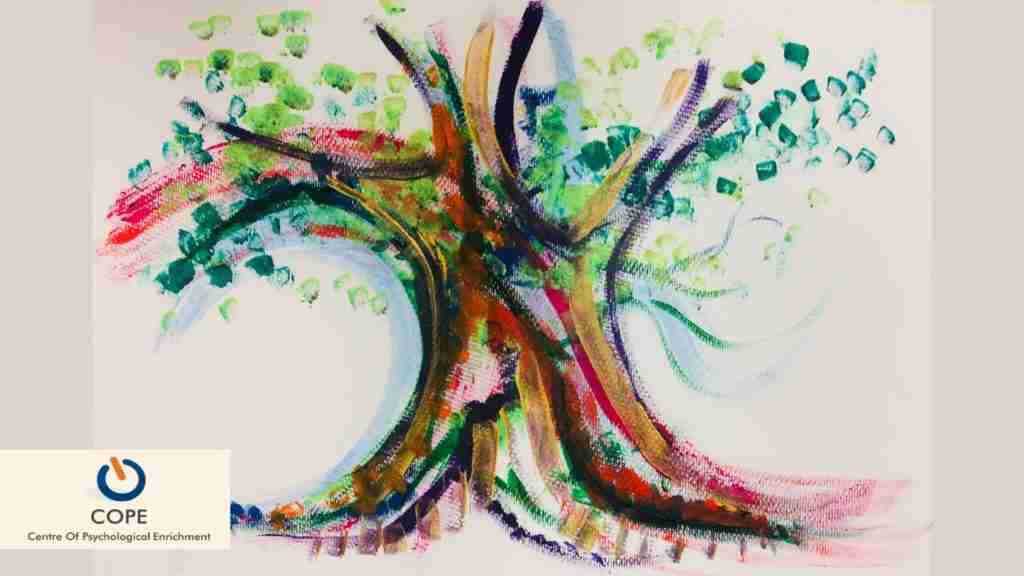What is SOMATISATION?
Soma is a Greek word and means “the living body”. Integrating techniques on somatic awareness in Arts Therapy adds a significant dimension to verbal exploration. In the psychodynamic framework of Creative Arts Therapy, we explore somatisation to help enhance self-awareness, self-growth and develop insight. We gain greater insight into bodily experience as an expression connected to psychological experience. Somatisation is a primitive defence. By working with creative processes, we learn to link somatic responses to defence mechanisms, internalisation and object relation. We examine how behaviour patterns formed in the past, have an impact on our present actions and reactions. And most importantly: question if they still serve a purpose.
FEELING FELT in Therapy – ART & the PSYCHODYNAMIC APPROACH
One characterization of Somatisation is the defence against underlying unconscious conflict. It may also represent an internal experience as a response to psychological stress. It is important to realize such shifts of physical experience in the body. In Arts Therapy at COPE, this is one of the main focuses. In clients with an unstable self-representation, we may perceive disruption in the transference relationship. This can produce distress, which can lead to physical discomfort and heightened bodily awareness. The therapist may also feel a somatic response, which becomes helpful in the transference/counter-transference relationship between therapist and client.
Somatisation and MOVEMENT
Interventions that are built around the use of creative modalities (such as dramatisation and visual arts techniques) assist emotional communication between therapist and client. They help raise the level of kinaesthetic experiencing and therefore allow the client to engage in an embodied way. Whether we feel emotionally stuck or physically impaired due to pain or tension, there is always movement. Movement happens on different levels. Our mind may be busy, or our body may tell us something hurts. Arts Therapy is action-based and an embodied approach, which means that all explorations within therapy are directed towards self-activation to help us move forward. But it is not always that simple and our psyche and body may coexist unbalanced, which can make us feel ‘out of control’, ‘disconnected’, ‘stuck’.
At COPE we use a bio-psycho-social model and look at the person holistically. Most important is to pay attention to the client’s relationship to and their perception of bodily symptoms and their somatic responses. Consequently, the client and therapist are able to check the client’s mental and physical flexibility, kinaesthetic, cognitive and creative awareness. Clients direct their attention “to embodied, inner experiences of self, actively reflecting and commenting on bodily sensations as they are raised into awareness. Gradually participants become more connected to their embodied, direct experience of self” (Gallagher & Payne, 2015). By enhancing our somatic awareness, we increase our understanding and conscious use of inner healing mechanisms. It is a process to create, observe, listen, speak, remember, think, reflect.
Our EMBODIED STORIES
As a matter of fact, our bodies tell and recall the many stories of our lives. They hold the feelings and emotions that we may have buried deep down in our unconsciousness. Giving those stories a space to be revisited, heard and reflected upon is one of the main intentions of arts therapy.
But how can we access these stories?
- By activating creativity and imagination, we initiate movement. This increases our somatic awareness.
- Clients learn to understand how tension and stress can be effectively worked with through the sensory use of different media.
- Painting creates movement in: fingers, hands, possibly upper limbs and sometimes the whole body.
- While touching and creating, we activate sensory motor skills and sensing at large.
- Grounding activities are part of therapy to develop towards rebalancing the body-mind connection.
- Main goal is to free the personality to grow, live and love in more creative ways.
EXPRESSING EMBODIED FEELINGS through METAPHOR: an example
All of a sudden I can breathe…
For more information on creative Arts Therapy watch our introduction video or read here.
References
Becker, Brian W., 1980- editor, Manoussakis, J. P., editor, & Goodman, D., 1980- editor. (2018). In Becker B. W., Manoussakis J. P. and Goodman D. M.(Eds.), Unconscious incarnations: Psychoanalytic and philosophical perspectives on the body (1st ed.). Routledge, Taylor & Francis Group. https://doi.org/10.4324/9781351180191
Burrill, R. (2010). The primacy of movement in art making. Teaching Artist Journal, 8(4), 216-228. https://doi.org/10.1080/15411796.2010.509198
Diamond, N. (2013). Between skins: The body in psychoanalysis–contemporary developments (1. Aufl. ed.). Wiley-Blackwell.
Halprin, D. (2003;2002;). The expressive body in life, art, and therapy: Working with movement, metaphor, and meaning. Jessica Kingsley Publishers.
Lavendel, F. (2017). Healing into wholeness: Psychotherapy practice informed by the discipline of authentic movement. Body, Movement and Dance in Psychotherapy, 12(3), 210-221. https://doi.org/10.1080/17432979.2016.1231135
Moon, B. L. (2007). The role of metaphor in art therapy: Theory, method, and experience. Charles C. Thomas.
Gallagher, S., & Payne, H. (2015). The role of embodiment and intersubjectivity in clinical reasoning. Body, Movement and Dance in Psychotherapy, 10 (1), 68-78. https://doi.org/10.1080/17432979.2014.980320
Shuper Engelhard, E., Pitluk, M., & Elboim-Gabyzon, M. (2021). Grounding the connection between psyche and soma: Creating a reliable observation tool for grounding assessment in an adult population. Frontiers in Psychology, 12, 621958-621958. https://doi.org/10.3389/fpsyg.2021.621958
